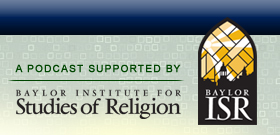

|
David Patel on Religion & Social Order in Iraq  Date: September 27th, 2015
 Why have many women in the Middle East resorted to increasingly conservative modes of dress in recent decades? And what happens after a political regime rapidly collapses leaving society in near total chaos as happened in Iraq in 2003? Dr. David Patel, a junior research fellow at the Crown Center for Middle East Studies at Brandeis University, answers these questions and accounts for the rise and success of ISIS by using a political-economic approach to religious institutions and behavior. He links these various topics through the importance of social coordination, signaling, and common knowledge to a society, and explains why Shiites were more successful in limiting violence and providing public goods than Sunnis were in Iraq following the US invasion in 2003. Our conversation begins with a bit of methodological banter as Tony asks David about the various analytical tools he uses including game theory, geospatial analysis, and ethnography. These theoretical and empirical techniques are rarely employed in conjunction with one another in the social sciences, and David offers a spirited defense of his multi-disciplinary approach and notes that ethnography has received a bad rap in the field of political science. We also talk about how these tools came to be applied to the study of religion and politics in the Middle East, and David and Tony share stories about how manuscript reviewers told them to submit their work to sociology journals since what they did “wasn’t political science.” We then turn to the topic of “veiling” broadly construed. David quickly corrects Tony’s use of that term noting that “veiling” refers to a covering of the face, but many forms of Islamic conservative attire need not do that, including the use of gloves or simple headscarves (hijabs). Nonetheless, David has noted an increase in the use of more concealing clothing amongst Muslim women in the past several decades. He links this phenomenon to the growing interest among all women for more modest and non-Western forms of apparel. However, when all (or most) women began wearing more conservative attire in the 1970s and ’80s, it created a situation where highly pious women were less able to signal their piety to potential mates in the marriage market. As such, there was a ramping up of concealing clothing so that the truly pious could differentiate themselves from those with less religious commitment. He explains this in the context of a societal marriage market and makes a case that social scientists should pay much more attention to this aspect of society. David further observes that there have been similar trends among men, with the length of beards and style of shoes being important markers for signaling religious adherence. The discussion shifts gears in a seemingly different direction as we pick up on the topic of Dr. Patel’s current book manuscript on the rebuilding of order in Iraq after the fall of Saddam Hussein. While appearing unrelated to the aforementioned topic of Islamic dress, the importance of information and coordination tie these two topics together. David notes how massive looting broke out in Iraq in mere days following the US invasion of Iraq and Hussein’s ouster as president. Such a chaotic situation is a rather untenable one for most people and the re-creation of social order becomes a necessity. Quickly after the collapse of the Iraqi state, we see the emergence of Friday mosque sermons as a means of coordinating local priorities, which is unusual as given that Friday sermons are comparatively rare. Shia mosques turned out to be more successful at coordinating such local priorities, facilitating common knowledge, and providing local public goods (e.g., trash pickup and security) as they had a more hierarchical structure under the direction of Ali al-Sistani. We conclude our interview with David’s thoughts on the rise of ISIS, why it has been successful, and some of the misconceptions both pundits and policymakers have about its organizational structure. He notes that ISIS’s simple ability to provide public goods and social order in areas where such order is lacking is what can account for its success. We finish with some of David’s personal “ah ha!” moments in his research, including the importance of local social norms and the realization that religion is not merely instrumental but something people hold to be intrinsically valuable. Recorded: September 25, 2015. RELATED LINKS David Patel’s bio at Association for Analytic Learning about Islam and Muslim Societies. Brandeis University’s Crown Center for Middle East Studies. “ISIS in Iraq: What We Get Wrong and Why 2015 is Not 2007 Redux,” by David Patel. RELATED PODCASTS Matthew Derrick on the Geography of the Umma. Ani Sarkissian on Politics and Religious Civil Society in Turkey. Paul Kubicek on Islam, Political Islam, and Democracy. Monica Toft on Religion, Terrorism, and Civil War. John Owen IV on Confronting Political Islam, Historical Lessons. Will Inboden on Religious Liberty, Foreign Policy, and the Arab Spring. Sean Everton on Dark Networks. Karen Elliott House on Journalism and Saudi Arabia. Ann Wainscott on Morocco’s Religious Foreign Policy.
Leave a Reply |
 Search The Podcast
To search the podcast, type a term and click the Search button.
  Browse Podcast Categories
Select a category below to browse the podcast:
   |














